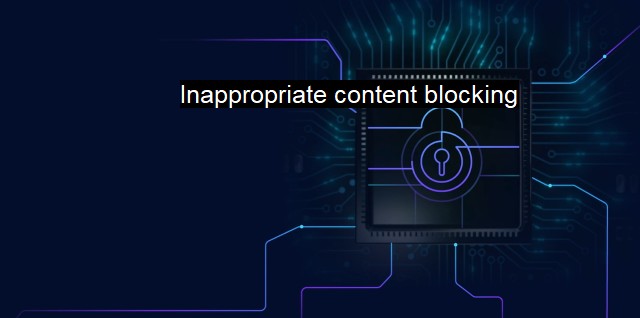What is Inappropriate content blocking?
Protecting Internet Users: Inappropriate Content Blocking Tools and their Significance in Ensuring Safe Online Experience
Inappropriate content blocking is a key feature in cybersecurity and antivirus software, which is designed to prevent users from accessing certain kinds of online content. It plays a crucial role in maintaining user safety and privacy, as well as promoting user confidence in the integrity of their personal data and information amid a vast web of interconnected systems.At a high level, the idea behind inappropriate content blocking is simple. The software analyzes content offered by websites, emails, or other online sources and if it is found to be dangerous, harmful, offensive, or literally, "inappropriate", it restricts the user from accessing it. Such schemes are essential to safeguard users from accessing malicious or inappropriate content, which could pose potential threats to their devices or themselves.
In the cybersecurity landscape, various means are used to trigger mechanisms for blocking inappropriate content. These methods spanning from content filtering techniques, URL filtering, to image analysis, all with the goal of enhancing online safety measures. Advanced cybersecurity software incorporates sophisticated algorithms and machine learning to constantly update its database of threat definitions, identifying and blocking suspicious or harmful elements before they have a chance to infiltrate the user's device.
In the realm of antivirus software, detecting and blocking inappropriate content helps keep threats such as spam, phishing scams, ad-aware, trojan horses, or potentially unwanted programs (PUPs) at bay. These threats are notorious for being transmitted through online content, and a robust content blocking feature in antivirus software can not only prevent an attack from such threats but can also alert the user about its presence. It's important to note that antivirus software doesn’t merely focus on blocking malicious content, but also content that can be considered inappropriate due to explicit, violent, or disturbing content.
The blocking of inappropriate content also helps parents and institutions to enforce internet safety rules for minors and restricted network users. Network administrators or parents, using appropriate software, can block access to explicit, violent, or adult-oriented internet sites. This end aids in ensuring that individuals use digital spaces comfortably and responsibly.
It is important to mention that mishandling or abuse of inappropriate content blocking can lead to false positives - where harmless and securely legitimate content is marked as dangerous or inappropriate. This can result in frustration for the user, as a certain level of false positives can effectively restrict freedom in the digital space.
While inappropriate content blocking is effective, its implementation is not without technical complexities and ethical concerns. For instance, deciding what content falls under 'inappropriate' can sometimes be subjective and contestable; users may dispute the "appropriateness" of content while administrators and software providers hold a conflicting point of view. This can generate issues of censorship and control of information.
Despite these challenges, inappropriate content blocking continues to be an invaluable cybersecurity feature. It is a proactive means of safeguarding users from a wide variety of online threats, making the digital environment safer, cleaner, and more conducive for both personal and professional use. The main objective is not to limit the freedom of digital navigation but to foster a secure and safe digital space for optimal usage of cyberspace.
Inappropriate content blocking is an essential part of modern cybersecurity and antivirus strategies. It is a system designed to help control the exposure of users to potentially harmful and malicious content. With rapid advancements in cyber threats, the role of content blockers in guaranteeing online safety continues to be pivotal, echoing their significance in the cybersecurity regime.

Inappropriate content blocking FAQs
What is inappropriate content blocking?
Inappropriate content blocking is a cybersecurity measure that restricts access to websites or online content that is deemed harmful, offensive, or inappropriate by an antivirus software or an organization's IT policy.What types of content can be blocked by inappropriate content blocking?
Inappropriate content blocking can be customized to block access to various types of content, such as pornography, gambling websites, social media, online gaming, or other non-work-related websites.How does inappropriate content blocking work?
Inappropriate content blocking works by using a filtering system that scans website URLs or content for certain keywords, phrases or patterns of behavior that indicates inappropriate content. When a user tries to access a blocked website, they will see a message indicating that access to the website has been denied.Is inappropriate content blocking effective in preventing cyber threats?
Inappropriate content blocking can be an effective cybersecurity measure to reduce the risk of cyber threats that could come from accessing websites that are known to be malicious or contain harmful content. However, it should not be the only cybersecurity measure used as it may have limitations in detecting new and evolving cyber threats.| | A | | | B | | | C | | | D | | | E | | | F | | | G | | | H | | | I | | | J | | | K | | | L | | | M | |
| | N | | | O | | | P | | | Q | | | R | | | S | | | T | | | U | | | V | | | W | | | X | | | Y | | | Z | |
| | 1 | | | 2 | | | 3 | | | 4 | | | 7 | | | 8 | | |||||||